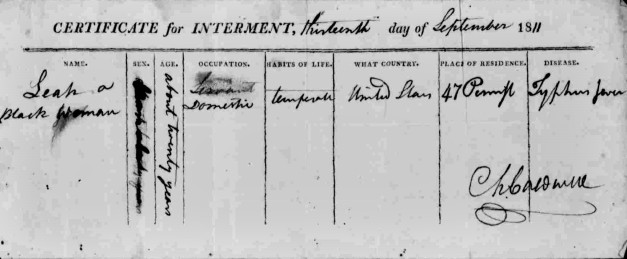
Leah, approximately twenty-years-old, died this date, September 13th, in 1811 of Typhus Fever and was buried at Bethel Burying Ground. The reason why no last name is recorded is a mystery. In addition, the change of her occupation on her death certificate from “Servant” to “Domestic” is unusual. Was she initially an indentured servant and then hired by the family as a free woman? Her residence at 47 Penn Street is a clue. It was the address of a wealthy merchant, Jehu Hollingsworth, who was “engaged in the West India trade.” Ms. Leah was also described as a temperate woman who was born in the United States.

In 1811 Ms. Leah lived within sight of the wharves that serviced the sailing ships which delivered goods from all over the world. The neighborhood was infected with rats from these vessels. It was the fleas and lice from these vermin that bite Ms. Leah and gave her the deadly Typhus Fever. Death was not immediate and the victim would suffer for weeks with a painful body rash, an excruciating headache, vomiting, diarrhea, delirium, rotting of the tongue, mouth, and nose. She suffered also with bleeding from all orifices, wracked by high fevers, alternating with shivering cold. The young woman would be blind and deaf when death came mercifully after weeks of suffering. It would be another 120 years before the development of a vaccine.

Ms. Leah was one of forty-three Philadelphians to die of Typhus Fever in 1811, according to the official Board of Health records. Approximately 60% of those who contracted the illness survived. Between 1836-1837, over 400 citizens were fatal victims of the disease.
*****
Note: Typhoid Fever is an entirely different disease than Typhus. Typhoid is caused by the ingesting of fecal material through contaminated water, milk or food.
